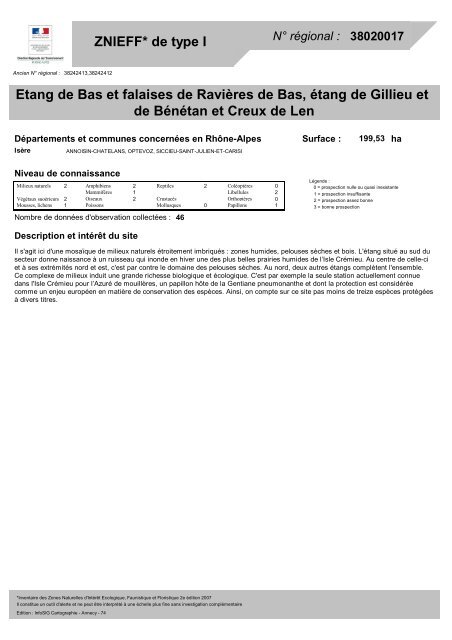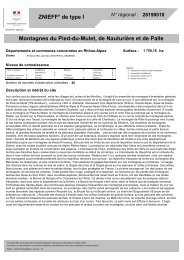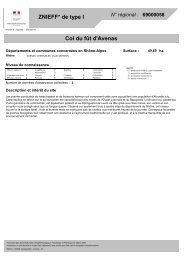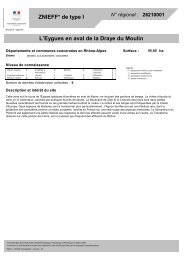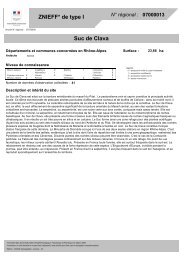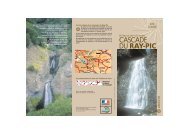Etang de Bas et falaises de Ravières de Bas, étang de Gillieu et de ...
Etang de Bas et falaises de Ravières de Bas, étang de Gillieu et de ...
Etang de Bas et falaises de Ravières de Bas, étang de Gillieu et de ...
You also want an ePaper? Increase the reach of your titles
YUMPU automatically turns print PDFs into web optimized ePapers that Google loves.
Ancien N° régional :<br />
38242413,38242412<br />
ZNIEFF* <strong>de</strong> type I<br />
N° régional :<br />
38020017<br />
<strong>Etang</strong> <strong>de</strong> <strong>Bas</strong> <strong>et</strong> <strong>falaises</strong> <strong>de</strong> <strong>Ravières</strong> <strong>de</strong> <strong>Bas</strong>, <strong>étang</strong> <strong>de</strong> <strong>Gillieu</strong> <strong>et</strong><br />
<strong>de</strong> Bénétan <strong>et</strong> Creux <strong>de</strong> Len<br />
Départements <strong>et</strong> communes concernées en Rhône-Alpes<br />
Isère<br />
Niveau <strong>de</strong> connaissance<br />
Milieux naturels<br />
Végétaux suoérieurs<br />
Mousses, lichens<br />
2<br />
2<br />
1<br />
ANNOISIN-CHATELANS, OPTEVOZ, SICCIEU-SAINT-JULIEN-ET-CARISI<br />
Nombre <strong>de</strong> données d'observation collectées :<br />
Description <strong>et</strong> intérêt du site<br />
Amphibiens 2 Reptiles<br />
2<br />
Mammifères 1<br />
Oiseaux<br />
2 Crustacés<br />
Poissons<br />
Mollusques 0<br />
46<br />
Coléoptères<br />
Libellules<br />
Orthoptères<br />
Papillons<br />
Surface :<br />
199,53<br />
Il s'agit ici d'une mosaïque <strong>de</strong> milieux naturels étroitement imbriqués : zones humi<strong>de</strong>s, pelouses sèches <strong>et</strong> bois. L'<strong>étang</strong> situé au sud du<br />
secteur donne naissance à un ruisseau qui inon<strong>de</strong> en hiver une <strong>de</strong>s plus belles prairies humi<strong>de</strong>s <strong>de</strong> l’Isle Crémieu. Au centre <strong>de</strong> celle-ci<br />
<strong>et</strong> à ses extrémités nord <strong>et</strong> est, c'est par contre le domaine <strong>de</strong>s pelouses sèches. Au nord, <strong>de</strong>ux autres <strong>étang</strong>s complètent l'ensemble.<br />
Ce complexe <strong>de</strong> milieux induit une gran<strong>de</strong> richesse biologique <strong>et</strong> écologique. C'est par exemple la seule station actuellement connue<br />
dans l'Isle Crémieu pour l’Azuré <strong>de</strong> mouillères, un papillon hôte <strong>de</strong> la Gentiane pneumonanthe <strong>et</strong> dont la protection est considérée<br />
comme un enjeu européen en matière <strong>de</strong> conservation <strong>de</strong>s espèces. Ainsi, on compte sur ce site pas moins <strong>de</strong> treize espèces protégées<br />
à divers titres.<br />
*Inventaire <strong>de</strong>s Zones Naturelles d'Intérêt Ecologique, Faunistique <strong>et</strong> Floristique 2e édition 2007<br />
Il constitue un outil d'alerte <strong>et</strong> ne peut être interprété à une échelle plus fine sans investigation complémentaire<br />
Edition : InfoSIG Cartographie - Annecy - 74<br />
0<br />
2<br />
0<br />
1<br />
ha<br />
Légen<strong>de</strong> :<br />
0 = prospection nulle ou quasi inexistante<br />
1 = prospection insuffisante<br />
2 = prospection assez bonne<br />
3 = bonne prospection
Milieux naturels Faune vertébrée<br />
34.32 PELOUSES CALCAIRES SUB ATLANTIQUES SEMI ARIDES<br />
34.33 PRAIRIES CALCAIRES SUBATLANTIQUES TRES SECHES<br />
Flore<br />
Ail joli<br />
Guimauve hérissée<br />
Cytise argenté<br />
Laîche faux-souch<strong>et</strong><br />
Gentiane <strong>de</strong>s marais<br />
Hélianthème à feuilles <strong>de</strong> saule<br />
Immortelle jaune<br />
Orchis bouc<br />
Lion<strong>de</strong>nt crépu<br />
Minuartie rouge<br />
Nénuphar jaune<br />
Esparc<strong>et</strong>te <strong>de</strong>s sables<br />
Pulsatille rouge<br />
Scabieuse blanchâtre<br />
Cumin <strong>de</strong>s prés (Fenouil <strong>de</strong>s<br />
chevaux)<br />
Silène conique<br />
Silène à p<strong>et</strong>ites fleurs<br />
Stipe pennée (Plum<strong>et</strong>, Marabout)<br />
Germandrée d'eau<br />
Bibliographie<br />
pages 2004 Consultable :<br />
BARDET O., HAUGUEL J-C<br />
Allium carinatum subsp. pulchellum Bonnier & Layens<br />
Althaea hirsuta L.<br />
Argyrolobium zanonii (Turra) P.W. Ball<br />
Carex pseudocyperus L.<br />
Gentiana pneumonanthe L.<br />
Helianthemum salicifolium (L.) Miller<br />
Helichrysum stoechas (L.) Moench<br />
Himantoglossum hircinum (L.) Sprengel<br />
Leontodon crispus Vill.<br />
Minuartia rubra (Scop.) McNeill<br />
Nuphar lutea (L.) Sm.<br />
Onobrychis arenaria (Kit.) DC.<br />
Pulsatilla rubra Delarbre<br />
Scabiosa canescens Waldst. & Kit.<br />
Silaum silaus<br />
Silene conica L.<br />
Silene otites (L.) Wibel<br />
Stipa pennata L.<br />
Teucrium scordium L.<br />
Conservatoire Botanique National Alpin<br />
Amphibiens<br />
Rain<strong>et</strong>te verte Hyla arborea<br />
Oiseaux<br />
Rousserolle turdoï<strong>de</strong> Acrocephalus arundinaceus<br />
Martin-pêcheur d'Europe Alcedo atthis<br />
Héron pourpré Ar<strong>de</strong>a purpurea<br />
Blongios nain Ixobrychus minutus<br />
Alou<strong>et</strong>te lulu Lullula arborea<br />
Guêpier d'Europe Merops apiaster<br />
Reptiles<br />
Cistu<strong>de</strong> d'Europe Emys orbicularis<br />
Faune invertébrée<br />
Libellules<br />
Aeschne printanière Brachytron pratense<br />
Agrion <strong>de</strong> Mercure Coenagrion mercuriale<br />
Leucorrhine à large queue Leucorrhinia caudalis<br />
Papillons<br />
Cuivré <strong>de</strong>s marais Lycaena dispar<br />
Azuré <strong>de</strong>s moullières Maculinea alcon<br />
Azuré <strong>de</strong>s paluds Maculinea nausithous<br />
Azuré <strong>de</strong> la sanguisorbe Maculinea teleius<br />
Bleu nacré d'Espagne Polyommatus hispanus<br />
Autoroute A48 Ambérieu - Bourgoin. Etu<strong>de</strong> <strong>de</strong>s inci<strong>de</strong>nces du proj<strong>et</strong> sur le site Natura 2000 FR 8201727 <strong>de</strong>s "<strong>Etang</strong>s, coteaux secs <strong>et</strong> grottes <strong>de</strong> l'Isle Crémieu"<br />
Contribution à l'écologie <strong>de</strong> la Leucorrhine à large queue (Leucorrhinia caudalis) <strong>et</strong> <strong>de</strong> la Leucorrhine à gros thorax (Leucorrhinia pectoralis) dans les marais <strong>de</strong> la Souche (Aisne -<br />
France).<br />
pages<br />
CADI A.<br />
2003 Consultable : Pôle Relais Tourbières<br />
Ecologie <strong>de</strong> la Cistu<strong>de</strong> d'Europe (E. orbicularis) :aspects spatiaux <strong>et</strong> démographiques, application à la conservation<br />
315 pages 2003 Consultable : CORA / FRAPNA Isère<br />
CADI A., CARAZ A., CHARLIGNY E., MIQUET A.<br />
Importance <strong>de</strong>s ceintures <strong>de</strong> végétation lacustre pour la conservation <strong>de</strong> la cistu<strong>de</strong> d'Europe (Emys orbicularis)<br />
pages<br />
2002 Consultable :<br />
DIREN Rhône-Alpes<br />
*Inventaire <strong>de</strong>s Zones Naturelles d'Intérêt Ecologique, Faunistique <strong>et</strong> Floristique 2e édition 2007<br />
Il constitue un outil d'alerte <strong>et</strong> ne peut être interprété à une échelle plus fine sans investigation complémentaire<br />
Edition : InfoSIG Cartographie - Annecy - 74
CHABROL L., GAILLARD N., DELMAS S. <strong>et</strong> al.<br />
Préservation <strong>de</strong> Maculinea alcon (Lep., Lycaenidae) en Limousin : exemples <strong>de</strong> gestion écologique<br />
p 2 pages 2001 Consultable : Pôle Relais Tourbières<br />
Conservatoire du Patrimoine Naturel <strong>de</strong> la Savoie<br />
Plan <strong>de</strong> gestion <strong>de</strong>s marais <strong>de</strong> Chautagne - phase 1 -<br />
15 pages 2000 Consultable : DIREN Rhône-Alpes<br />
Conservatoire Régional <strong>de</strong>s Espaces Naturels <strong>de</strong> Rhône-Alpes<br />
Cistu<strong>de</strong> d'Europe (la). Gestion <strong>et</strong> restauration <strong>de</strong>s populations <strong>et</strong> <strong>de</strong> leur habitat. Gui<strong>de</strong> technique<br />
108 pages 2004 Consultable : AVENIR<br />
Conservatoire Régional <strong>de</strong>s Espaces Naturels <strong>de</strong> Rhône-Alpes Rhône-Alpes<br />
Suivi <strong>de</strong>s populations <strong>de</strong> Cistu<strong>de</strong> d'Europe (Emys orbicularis) <strong>de</strong> l'Isle Crémieu. Première phase : 1999<br />
25 pages 1999 Consultable :<br />
CORA<br />
146 pages 2002 Consultable :<br />
CORA Drôme<br />
Conservatoire Régional <strong>de</strong>s Espaces Naturels <strong>de</strong> Rhône-Alpes<br />
Reptiles <strong>et</strong> amphibiens <strong>de</strong> Rhône-Alpes : atlas préliminaire, hors série n°1<br />
Oiseaux <strong>de</strong> la Drôme<br />
312 pages 2003 Consultable :<br />
DELIRY C., GRAND D. <strong>et</strong> al.<br />
21 pages 1998 Consultable :<br />
FREMILLON J-L<br />
Conservatoire Régional <strong>de</strong>s Espaces Naturels <strong>de</strong> Rhône-Alpes<br />
DIREN Rhône-Alpes<br />
L'Agrion <strong>de</strong> Mercure (Coenagrion mercuriale) dans la Moyenne vallée du Rhône : mise en perspective <strong>de</strong>s données par rapport à la région Rhône-Alpes<br />
p 1- pages 1990 Consultable :<br />
GRAND D.<br />
CORA / FRAPNA Isère<br />
Le Blongios nain (Ixobrychus minutus) en Isère<br />
Les libellules du Rhône<br />
Muséum d'Histoire Naturelle <strong>de</strong> Grenoble<br />
255 pages 2004 Consultable : Société Linnéenne <strong>de</strong> Lyon<br />
JORDAN J-P., BIROT-COLOMB M.<br />
Enquête sur le Blongios nain<br />
p 1 pages 2004 Consultable :<br />
LAFRANCHIS T.<br />
448 pages 2000 Consultable :<br />
PRIOL P.<br />
Muséum d'Histoire Naturelle <strong>de</strong> Grenoble<br />
Les papillons <strong>de</strong> jour <strong>de</strong> France, Belgique <strong>et</strong> Luxembourg <strong>et</strong> leurs chenilles<br />
52 pages 2002 Consultable :<br />
ROZIER Y.<br />
Conservatoire Régional <strong>de</strong>s Espaces Naturels <strong>de</strong> Rhône-Alpes<br />
Etu<strong>de</strong> <strong>de</strong> l'activité <strong>et</strong> <strong>de</strong>s patrons <strong>de</strong> déplacements chez <strong>de</strong>ux populations <strong>de</strong> cistu<strong>de</strong>s (Emys orbicularis) du Nord-Isère en vue <strong>de</strong> leur conservation<br />
32 pages 1995 Consultable :<br />
Conservatoire du Patrimoine Naturel <strong>de</strong> la Savoie<br />
Biologie <strong>de</strong> la conservation <strong>de</strong>s Azurés (Maculinea sp.) dans la Réserve Naturelle du Marais <strong>de</strong> Lavours<br />
p 2 pages 1998 Consultable :<br />
DIREN Rhône-Alpes<br />
Les Maculinea (Lepidoptera, Lycaenidae) <strong>de</strong>s zones humi<strong>de</strong>s : l'exemple <strong>de</strong> la Réserve naturelle du Marais <strong>de</strong> Lavours (Ain, France)<br />
13 pages 1997 Consultable :<br />
DIREN Rhône-Alpes<br />
Suivi Maculinea - Marais <strong>de</strong>s Bidonnes - été 1997<br />
22 pages 1999 Consultable :<br />
DIREN Rhône-Alpes<br />
Suivi scientifique du complexe Maculinea-Sanguisorba / Gentiana-Myrmica dans la Réserve Naturelle du Marais <strong>de</strong> Lavours - Rapport d'activité 1999<br />
DIREN Rhône-Alpes<br />
*Inventaire <strong>de</strong>s Zones Naturelles d'Intérêt Ecologique, Faunistique <strong>et</strong> Floristique 2e édition 2007<br />
Il constitue un outil d'alerte <strong>et</strong> ne peut être interprété à une échelle plus fine sans investigation complémentaire<br />
Edition : InfoSIG Cartographie - Annecy - 74
38020093<br />
38020093<br />
8020122 020122<br />
020122<br />
38020056<br />
38020056<br />
Légen<strong>de</strong><br />
38020121<br />
38020121<br />
38020033<br />
38020033<br />
38020124<br />
38020124<br />
Périmètre <strong>de</strong> la ZNIEFF type 1<br />
38020033<br />
38020033<br />
38020121<br />
38020121<br />
38020017<br />
38020017<br />
38020124<br />
38020124<br />
* Inventaire <strong>de</strong>s Zones Naturelles d'Intérêt Ecologique, Faunistique <strong>et</strong> Floristique 2e édition 2007<br />
Il constitue un outil d'alerte <strong>et</strong> ne peut être interprété à une échelle plus fine sans investigation complémentaire<br />
Edition : InfoSIG Cartographie - www.infosig.n<strong>et</strong> - Annecy<br />
Inventaire du patrimoine naturel<br />
ZNIEFF* N°38020017<br />
38020011<br />
38020011<br />
38020123<br />
38020123<br />
38020123<br />
38020123<br />
38020062<br />
38020062<br />
38020095<br />
38020095<br />
<br />
Echelle : 1 / 25 000<br />
fonds IGN Scan 25 (C)<br />
3802012 380201<br />
380201<br />
38020 3802<br />
3802<br />
38020 3802<br />
3802<br />
3802 380<br />
380


